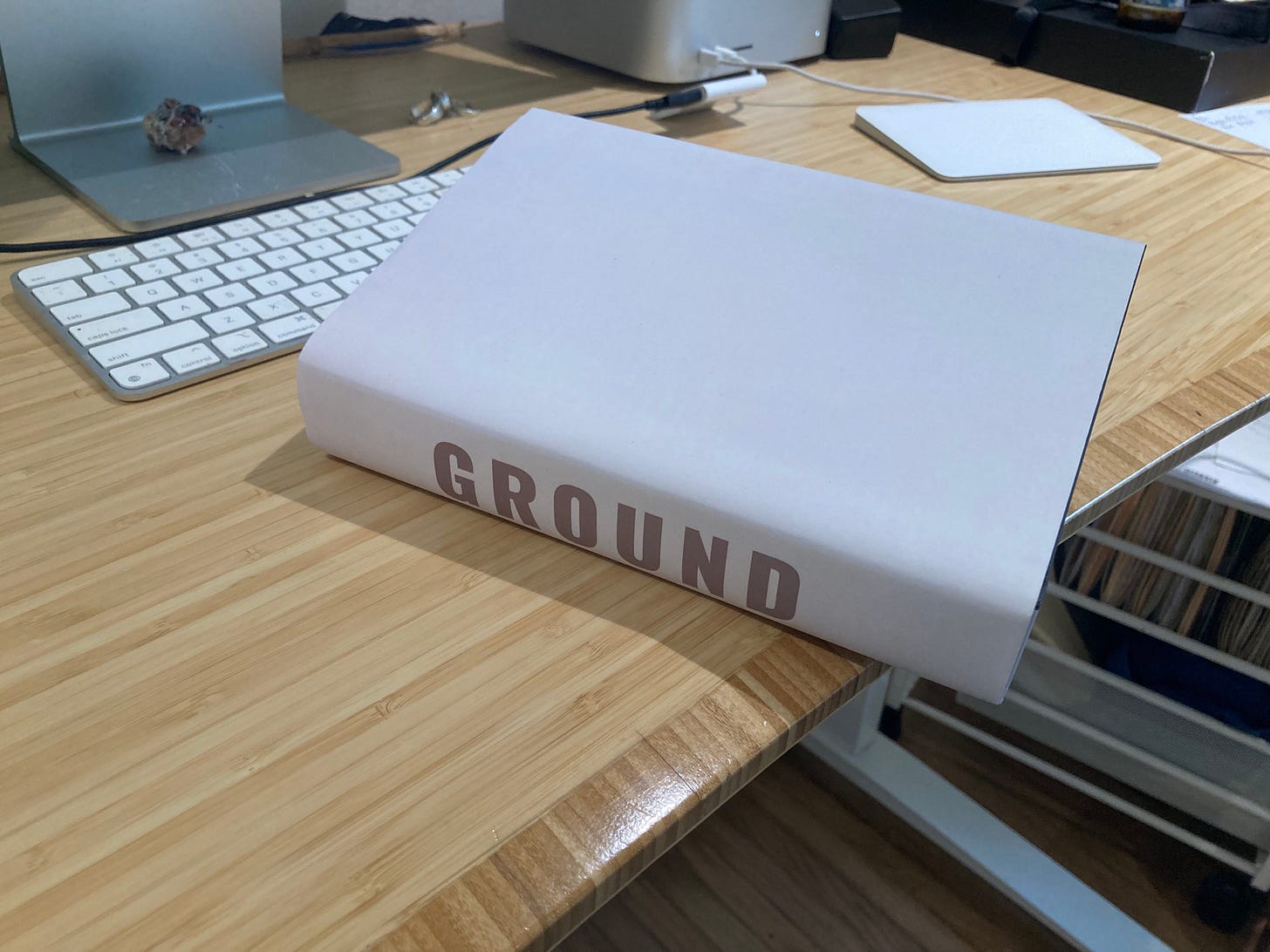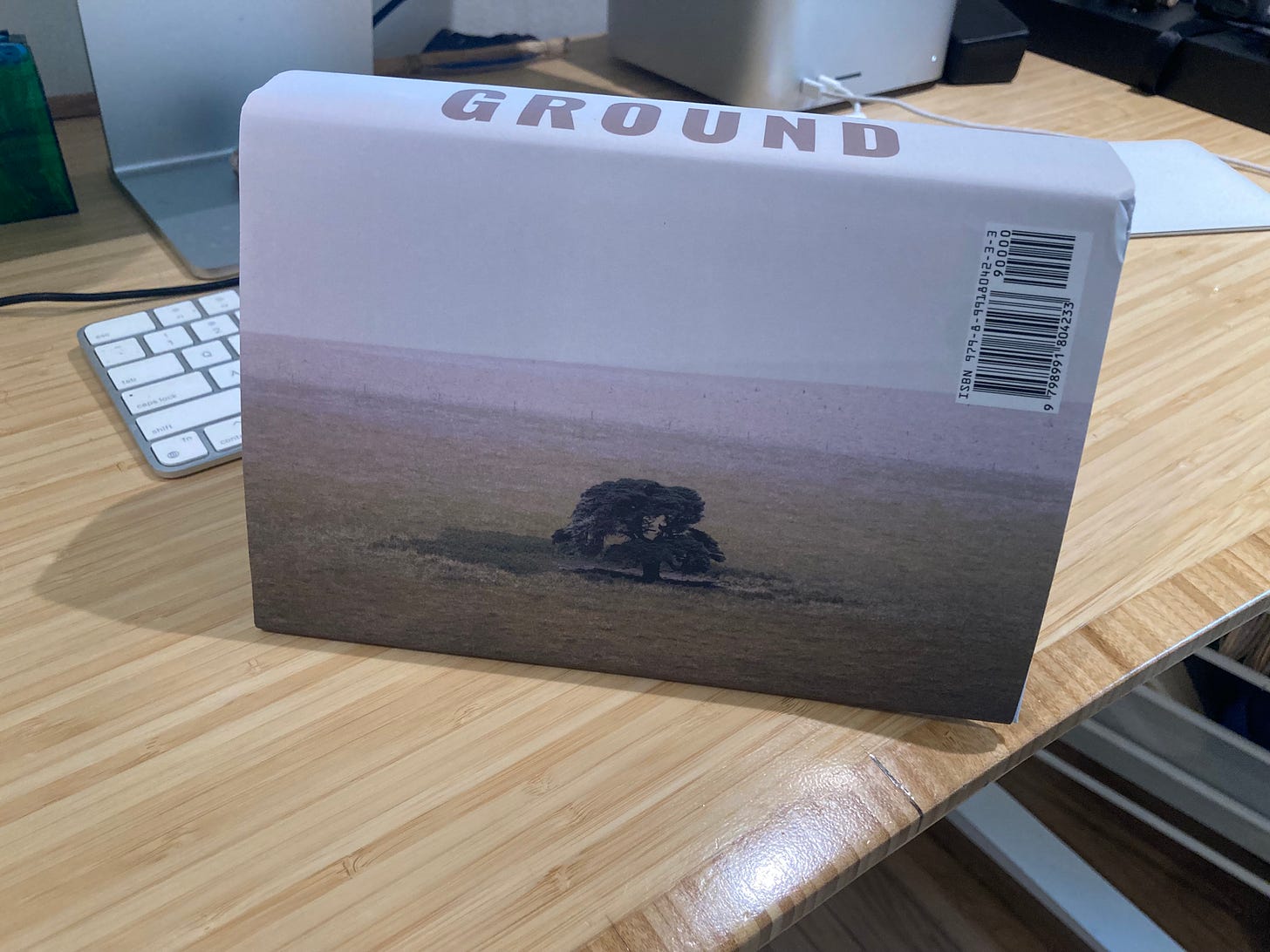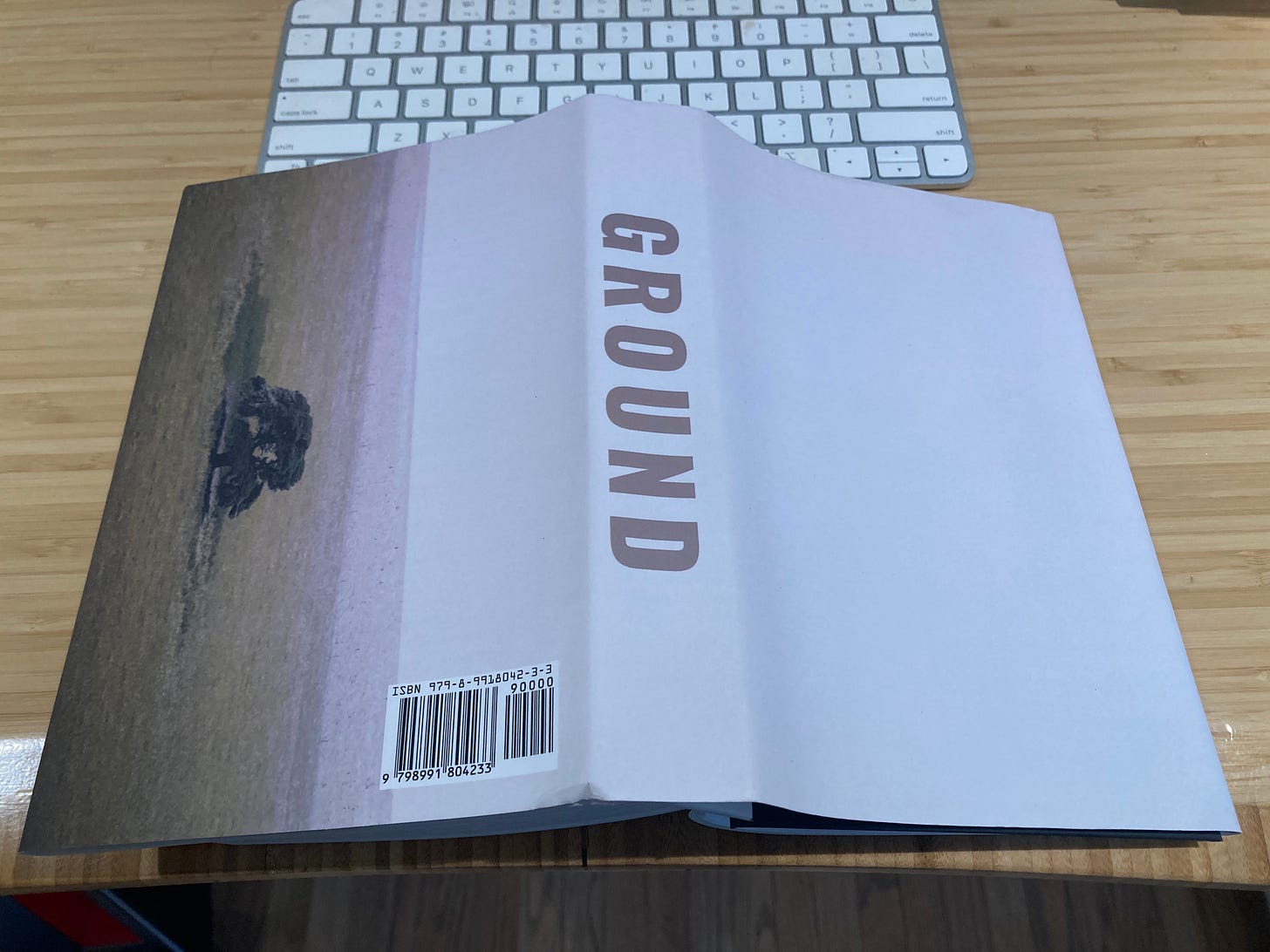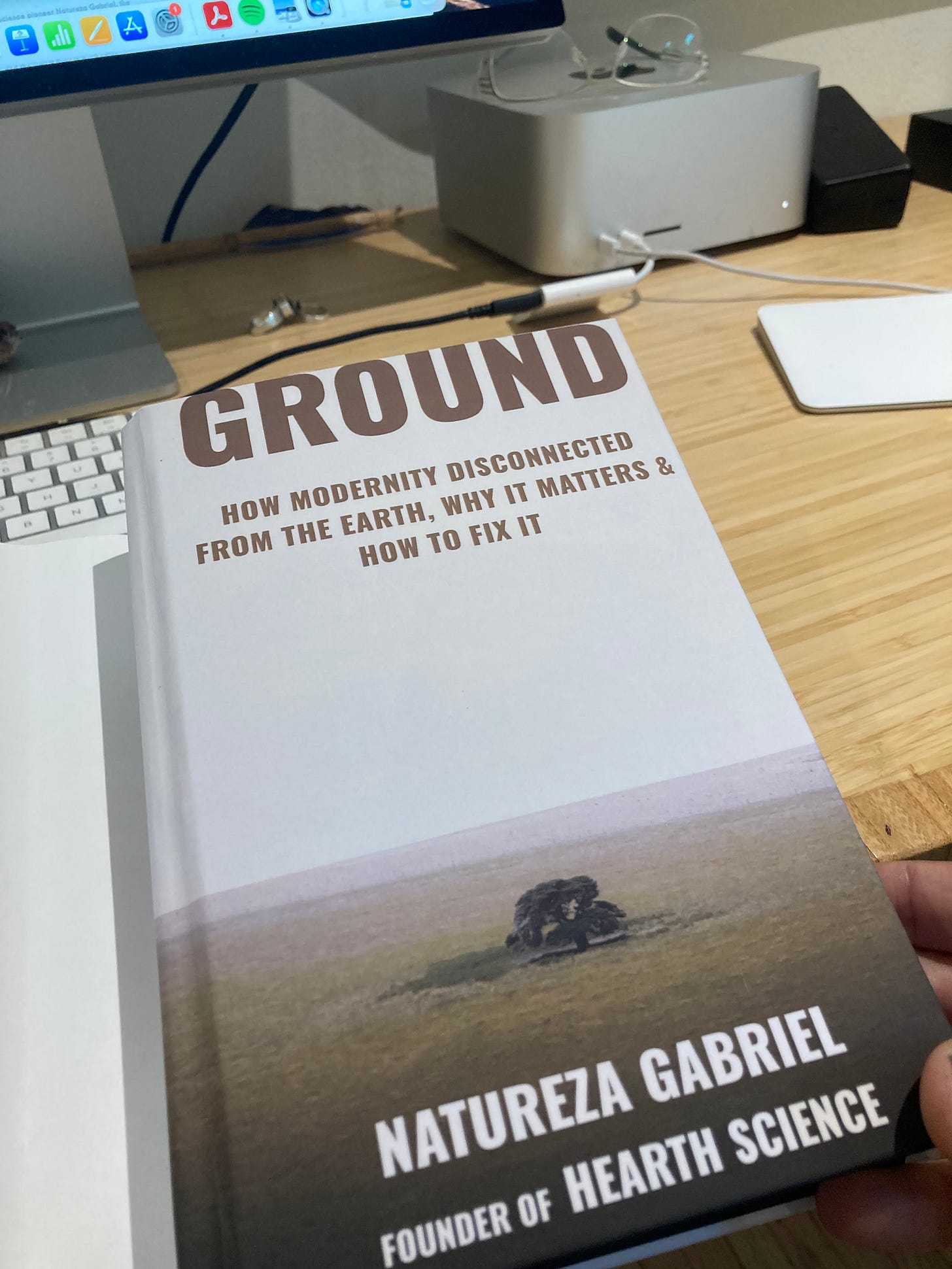Advance Review Copies of Ground in hand
There is always this feeling I get holding a new book. It is not something that there is an English word for. I think some part of it is the gulf between the digital realm, where I work on a book and compose it, design it…and the tangible physical object. The ‘becoming real’ of it. It always feels a bit like holding a baby for the first time, although I know that’s an odd thing to say.
Moment of arrival, book in hand for first time.
Late yesterday afternoon, I received three advanced review copies of Ground. The timing of this felt both auspicious and unexpected. Yesterday morning I finished the second day of a training about the book, on grounding as practice and process.
One of the most satisfying things about writing the The Neurobiology of Connection was the amount of feedback that I got on chapters from our audience on this substack. Thank you all so much! Since part of why I write is to learn what I know, and since I want to share what I understand, this call-and-response with a collective was extraordinarily motivating as I was writing the book. For any given published chapter we’d get ten to twenty comments, and the questions and inspirations that people felt in reading were wonderful fuel to help create the next chapters.
Because of the way Ground came together, its assembly process, the degree to which I was compiling it from various places, as much synthesis as new generation, I couldn’t get this kind of feedback from our community of readers because the leading edge of writing wasn’t the forward progression of chapters. And so since early April, I have been convening small groups and teaching the book. I say ‘teaching the book’, but that’s fairly loose and maybe generous in the interpretation. I’ll read a chapter here and there, but mostly we are tracking the spontaneous rise and fall of conversations around what it means to be grounded at this moment in time.
I have the feeling that this conversation touches on so many different aspects of our lives. My sense of the world as it presently exists, which all of us walk into like actors walking into the middle of a scene that’s already at play (en medias res is the theatrical term for this), is a world that is 5000 years downstream of the domination paradigm. Imperial power has, for the last several thousand years, been systematically working to uproot us from the ground. An empire wants malleable and dutiful citizens who do what they are told and who it can control. And I’ll just tell you that sovereign earth-based people do not fit that criteria.
And so part of the function of empire as a construct for the last several thousand years has been to systematically dismantle the deep rootedness that humans have felt in relationship to place and community. Because the focus of my work is autonomic physiology, this may sound like an unusual place to start, but I would propose that its impossible for us to understand the nature of modern trauma, and the physiology of the shutdown response, without understanding this broader civilization context.
What I’m trying to do in the book is look at three inter-linking layers. I’m trying to look at the past 12,000 years of our civilization history. I’m trying to look at the last several hundred years of my family’s lineage history, particularly as it has shaped the generations I’ve known since I was born, back to my great-grandparents. And I’m trying to look at the arc of my own life. Like most fractals, these three different times scales have some patterns that are similar at varying levels of scale. Throughout all of this, I am weaving in a deep exploration of the neurophysiology of the Grounding System, which is what Polyvagal Theory calls the Dorsal Vagal system. One of our important recognition is that the system is only connected to shutdown when we are in lifethreat responses. It also has a salutogenic aspect, when it’s coordinating with other autonomic systems in the production of health-creating states, so I’m both curious as to how we get pushed into the defensive lifethreat version of this response, and how we can reclaim our Grounding Systems as a foundation of Connection to the Earth, rootedness in place, and relatedness to the whole of the living world. It feels to me like this question is timely, urgent, and important.
This is a major and significant release for us. It is the second book in the Autonomics Trilogy. And for these kind of books, I like to do something new. I was pleased with the way that the case jacket in The Neurobiology of Connection can be converted into a poster. I thought that the cover was elegant, and that having no text on the front of the outside, with simply the Autonomic Mandala, made the appearance of the book intriguing. For Ground, we’ve elected a hardcover version with a case jacketed treatment again. I am very interested in your feedback on this aesthetic choice. Below there are several pictures of the book. I’d like to know whether you find the cover usefully disarming to expectations, or silly. It appears to be totally blank. But that’s only because the front cover is not the full context of the jacket. Turn the book sideways, or rotate it, and you can see that the ground is actually on the back cover. What seemed to be blank is actually sky. My hope, without being too clever, is that this is sort of a meta commentary on what the book is about. Let me know if you think I’ve succeeded. You can pre-order ground with the button below. Your support is part of what allows us to continue taking these big swings at important topics. The book will be arriving in December 2025. Current version weighs in at 438 pages, hardcover, full-color illustrations, with the case jacket described above.
Just as a publishing note aside, typically an advanced review copy would not have a case jacket, and fully designed cover. Since we are also designing the books and publishing them through our own literary imprint, we do this early so that we can see how things are working. The inside hardcover, as we discovered yesterday, is not printing correctly. (Title is way too high.) Our team wants to know that now, not closer to publication.








Congratulations on breaking new Ground! ;)
When looking at the imagery of the cover I was imagining going into a bookshop (people do still do this, right?!) and encountering the book. I imagine I would see the "blank" cover and be intrigued, turn the book to see the spine in an attempt to satisfy my curiosity and then probably turn it around to see the back. Personally I love the tree image and so that would draw me to open the book and delve more into it. So I think it works.
One point I'd make is that it appears in the images provided that spine background colour (i.e. that holds the text "GROUND") is a different colour to the front cover sky and top of the back cover. This, for me, creates a visual divide between the ground (i.e. tree image) and the sky.
A final thought is the option of providing an instruction somewhere (e.g. this sleeve makes one image) but this may take all the fun away.